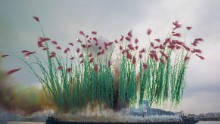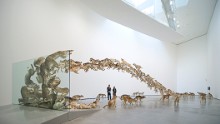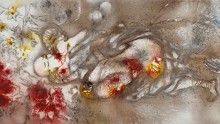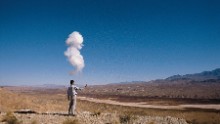Cai Guo-Qiang: The artist who 'paints' with explosives 用爆炸作畫的藝術家 -蔡國強

(CNN)-While
other artists turn to the easel with paint or pastels, Cai Guo-Qiang prefers to
make a statement with explosives.
(CNN)-當其他的藝術家們拿著顏料和粉彩轉向畫架時,蔡國強則選擇用爆破來表現。
Born
in Quanzhou, China but based in New York, Cai has made a career from bending
gunpowder to his will. His most well-known work arguably takes two divergent
routes: aerial firework displays or vast gunpowder paintings made by detonating
large trails of it on to paper, ignited live in front of a live audience.
Transient or permanent, his oeuvre is always spectacular.
蔡國強出生於中國泉州,但在紐約紮根生活,他如自己所願的開啟了探索火藥的職業生涯。他最有名的作品無疑是採用兩種不同的方式:空中的煙火秀或是藉由在紙上引爆一大串火藥的大型火藥圖,在現場觀眾面前現場點燃。不論是稍縱即逝的或是永久留存的,他的所有作品總是很壯觀。

"The
most powerful artwork is when there's fear," says Cai, speaking from Qatar
where he has curated an exhibition of Chinese artists, commissioned by Sheikha
Al Mayassa.
由館長Sheikha Al Mayassa委任蔡國強在卡達策畫中國藝術家聯展時,他說:「恐懼能創造出最震撼的作品。」
When
it comes to explosions, he hasn't always been in such control. Cai says he owes
a debt to his grandmother, who came to the rescue during his first experiments
with gunpowder. "Once I ignited the fire [and] the entire canvas lit
up," he recalls. "She just put a rug in the living room over the
fire. From a young age I've learned a lot from her." He says his next
piece will be dedicated to her.
只要一提到爆炸,他就無法自拔。蔡國強說他欠他祖母一個人情,她在他第一次實驗炸藥時前來救援。他回想起:「有一次我點火之後,整個帆布都燒起來,而我奶奶只是在客廳蓋上一塊地毯滅火,我從年輕的時候,就從她身上學到很多。」他說他的下一個作品將獻給她。
While
not all of the artist's work involves explosions -- one of his most famous
pieces "Head On" is a gravity-defying sculpture made with 99
life-sized replicas of wolves -- the unifying theme is spectacle. He transcends
cultural boundaries by creating a dialogue between viewers and the world around
them.
然而這個藝術家的作品也不是都跟爆炸有關,他其中一樣有名的作品「撞牆」,是用99隻跟真狼一樣大的複製品作成的反重力雕塑品,這結合式的主題成了奇景。他藉由營造參觀者和周遭世界的對話,橫跨文化的隔閡。

Working
across various mediums including drawing, installation, video and performance
art, his work is internationally renowned, with accolades including the Golden
Lion at the 48th Venice Biennale in 1999, the 7th Hiroshima Art Prize in 2007,
and the 20th Fukuoka Asian Culture Prize in 2009. He was also Director of
Visual and Special Effects for the opening and closing ceremonies of the 2008
Summer Olympics in Beijing.
他運用不同的表現方式創作,包含繪畫、現代雕塑裝置、影像及現代藝術,他的作品享譽國際,所得到的獎項包括1999年第48屆威尼斯雙年展金獅獎、2007年第7屆廣島獎以及2009年獲第20屆福崗亞洲文化奬。他同時也是2008年北京奧林匹克運動會開閉幕式視覺特效藝術總監。
"Throughout
Chinese art history, some artists have been pursuing their own artistic
language and how to use this language to convey and connect," he explains.
Cai's is certainly unique, a medium he says he uses to explore Eastern
philosophy, Maoist sentiment and contemporary social issues.
他說明:「一直以來在中國藝術史,有些藝術家一直在追求他們自己的藝術語言以及如何用此去表達和連結。」蔡國強的藝術語言無疑是特別的,他所提到的表現手法,用來探索東方哲學、毛澤東的思想及現代社會議題。

"People
will look into Chinese political and social issues and artists have to show
their society," he argues, "but people have neglected the individual
creativity, artistic attitude, concepts and the art itself."
他爭論:「人們會研究中國政治和社會議題,而藝術家必須展現他們的社會,但是人們一直以來都忽略了個體的創造力、藝術的態度、概念和藝術本身。」
With
the artistic process front and center of Cai's work, you couldn't avoid it if
you tried. And after leaving one of his performances, ears ringing, he can be
sure his message will have been heard.
如果你經歷過在蔡國強的作品面前及中心的藝術過程,你就無法移開視線。然而在他留下他的藝術表現之後,耳邊將會嗡嗡作響,他很確定他想傳達的訊息會被聽到。

